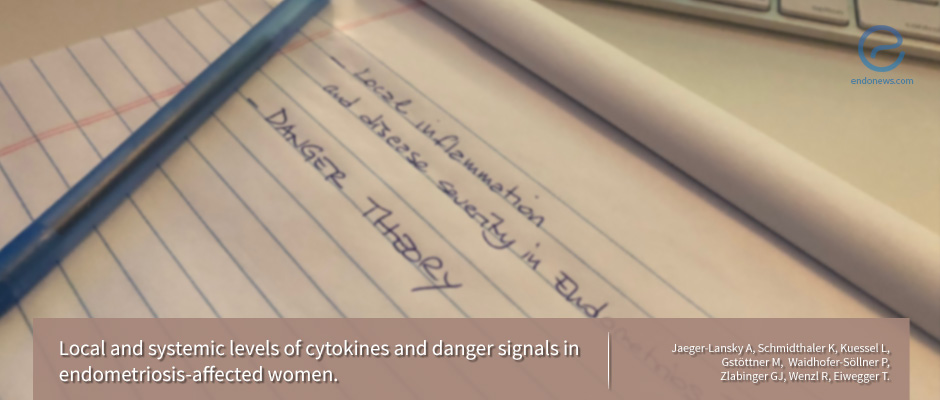Local inflammation and disease severity in endometriosis
Jan 30, 2019
No evidence of danger theory in endometriosis pathogenesis
Key Points
Highlight:
- Endometriosis is associated with local inflammation but not related to danger-associated molecular patterns (DAMPs) or ‘alarmins’, otherwise known as the “danger theory”.
Importance:
- “Danger signals” reflect tissue damage and is released during cell death in response to strong inflammation. This study examined local inflammation and the severity of the disease, as well as DAMPs.
What's done here:
- Plasma and peritoneal fluid samples were collected from 45 women with histologically proven endometriosis and 35 women without endometriosis.
- Levels of cytokines, i.e., IL-6, IL-8, IL-10, IL-1β, TNF-α, and INF-γ were quantified via a bead-based multiplex assay.
- Levels of IL-32α, IL-33, and HMGB1 were measured using sandwich enzyme-linked immunosorbent assays.
Data:
- Higher levels of IL-6, IL-8, IL-10 and TNF-α levels in peritoneal lavage fluid of endometriosis patients.
- IL-10 and IL-6 levels were significantly higher in patients with ovarian lesions.
- This local inflammation was not seen systemically as plasma levels did not show any differences.
- Severity and pain scores did not correlate with these cytokine levels.
- “Danger signals” HMGB1, IL-32α, and IL-33 levels were similar between women suffering from endometriosis and control individuals.
Limitation:
- The study sample size is small, and may thus carry inherent bias.
Lay Summary
During inflammation, immune cell receptors recognize endogenous molecules called danger-associated molecular patterns (DAMPs) or ‘alarmins’. This process reflects tissue damage and is mediated upon cell death in the condition of strong inflammation. HMGB1 and IL-33 are important DAMP molecules.
Recently, some studies have suggested the role of these “danger signals” in endometriosis pathogenesis. However, data on levels of these danger signals and mechanisms in endometriosis is limited.
This study by Jaeger-Lansky et al. from Department of Obstetrics and Gynecology, Medical University of Vienna, Vienna, Austria aimed to determine levels of inflammatory cytokines and “danger signals” in women with endometriosis. This study was published in the "Journal of Reproductive Immunology".
Plasma and peritoneal fluid specimens were collected from 45 women with histologically proven endometriosis (age 34.2 ± 7.8 years) and 35 women without endometriosis (age 36.4±8.0 years). The levels of cytokines IL-6, IL-8, IL-10, IL-1β, TNF-α, and INF-γ levels were quantified using multiplex assay and danger signals IL-33 and HMGB1 measured with enzyme-linked immunosorbent assays.
The authors found significantly higher levels of IL-6, IL-8, IL-10 and TNF-α levels in peritoneal lavage from endometriosis samples. The patients with deep infiltrating endometriosis showed higher IL-10, IL-8, IL-6 and TNF-α than the control group. Moreover, IL-10 and IL-6 were positively upregulated in patients with ovarian lesions.
Plasma cytokines levels did not show significant alteration, thus these changes seemed local and not systemic inflammation. Plasma levels did not show any differences between the groups. Unfortunately, severity and pain scores did not correlate with these cytokine levels either in peritoneal fluid or plasma. Levels of the danger signals of HMGB1, IL-32α and IL-33 were similar between women suffering from endometriosis and control individuals.
Therefore, this study, coherent with other published works, have shown that there is a dysfunctional local immune response in endometriosis. However, the importance and relevance of “danger theory” in endometriosis is unclear. These data may be important in determining useful future biomarkers and therapeutic targets for endometriosis.
Research Source: https://www.ncbi.nlm.nih.gov/pubmed/30099220
immune system inflammation

